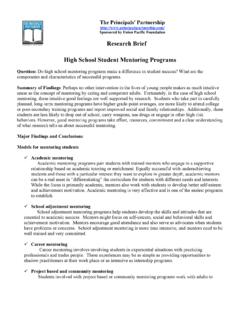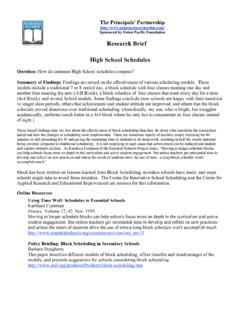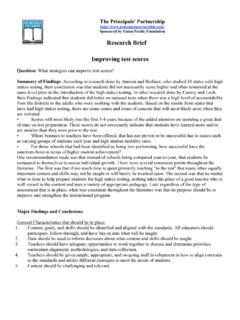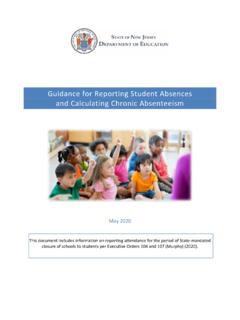Transcription of Research Brief Strategies for dealing with tardiness
1 The Principals' by Union Pacific Foundation Research BriefStrategies for dealing with tardinessQuestion: What works to reduce tardiness ?Summary of Findings: Principals and teachers have long thought that student tardiness was a seriousproblem. In one study from the 1990 s, 8-12% of students were absent each day, and more than 40% ofteachers found tardiness to be a significant problem. In fact, it is considered so serious that a school sresponse can go to extremes: a student in Mount Pleasant, MI, was suspended for writing and reading aparody of the school s tardiness policy, and students in one California high school are fined $165 if they aretardy more than twice.
2 A Google search on tardiness will yield a lot of high school online handbooks andpolicies about tardiness . The question, of course, is not what are high schools doing? , but what are highschools doing that s working? Many approaches seem to work, but they tend to break into two categories:the behavior modification approach and the needs-based modification approaches include the following: being locked out of class; detentions; parentconferences; additional assignments; reductions in grades; work details during lunch, after school, or freeperiods; Saturday classes; token systems for being on time; time cards; time management workshops;contingency contracts; and tardy rooms.
3 Many of these Strategies proved effective, but detentions, reducedgrades, tardy rooms, and additional assignments proved ineffective at changing schools, however, look at the reasons that students are tardy and try to address the underlyingproblems. This approach is based on the idea that before a school can change the behavior of at-riskstudents, they must understand what is going on in those students lives. When asked through interviews orsurveys, students indicated that they were tardy for the following reasons: transportation problems;overcrowded conditions; lack of positive history about people of color; lack of a culturally sensitivecurriculum; dirty and limited access to bathrooms;; health-related causes; sleeping habits; and family-relatedexcuses.
4 Such studies often found that tardy students felt a disconnect with the school, the teachers, or thecurriculum. From one study: Students complained about the inconsistency of school rules, especially thoserelated to tardiness and eating in school, and they noted the double standard that allowed teachers to do manythings students were not allowed to do. They voiced concerns that they were never given a say aboutanything in the school, expressing the belief that all the rules originated with teachers and staff, and thatstudent input was not solicited. When they did express opinions about school, they thought that theircomments were not taken seriously.
5 Successful needs-based Strategies included the following: identifying chronic offenders, assessing themindividually, and referring them to appropriate services, including support groups; working with parents tofind solutions; instituting free breakfast programs; working with teachers to improve the quality of theinstructional program; switching to Block scheduling; interdisciplinary & integrated curriculum; andproviding opportunities for students to express their opinions and contribute to the operation of the Principals' by Union Pacific Foundation Research BriefNeeds-based approaches had the added benefit of not only improving punctuality, but often academicachievement and attitude toward school, as one study says.
6 Even the best attendance policy must be accompanied by an understanding of studentmotivation. Schools must look at whether alienation is playing a part in absences. Other factors, such ascultural values, socialization, social responsibility, academic rigor, and school climate, must also beconsidered when examining attendance patterns. Online Resources:GENERAL RESOURCESS tudent Absenteeism and tardiness . Indicator of the important aspect of students' access to education is the amount of time actually spent in theclassroom. This Brief highlights data on the student absentee rate for 1990-91.
7 The data wereextracted from "The Condition of Education, 1995," Department of Education, National Centerfor Educational Statistics. ERIC #: ED396461 :80/ Suspends Student Over tardiness ParodySeptember 6, 2001 MOUNT PLEASANT, Michigan (AP) -- A lawsuit was filed on behalf of a student who wassuspended after reading a parody of his school's tardiness policy to a group of friends in the 's commentary, written at home, criticized the school's new tardiness policy, the process leadingto its adoption, and several teachers and administrators responsible for enforcing it.
8 He wassuspended because he allegedly assaulted "the dignity of a person," the ACLU with TardinessFor the Sake of Argument (A blog for discussing issues of important to the heartland of America. )December 02, 2003A Whittier (CA) high school is cracking down on tardy students. Students at Whittier High Schoolwho arrive on campus after the 8 bell more than twice will be fined $165 by the Whittier PoliceDepartment, Principal Loring Davies Do You Handle Chronic tardiness ?Teachers at different levels explain their solutions to tardiness . From NEA Today September 2001,The Principals' by Union Pacific Foundation Research Briefpage 27 $82 NEEDS-BASED APPROACHB uilding Successful Students: Creating Disciplinary Policies That Promote CollegeA Plan for Improving Roosevelt High SchoolIn the spring of 2002 United Students began a student-led Research process to identify the mainproblems at Roosevelt and develop solutions.
9 United Students distributed a survey to the RHSstudent body in classrooms, and collected surveys from 754 students. The student leaders analyzedUS survey findings, RHS graduation and college eligibility rates, and two Times news articleswhich highlighted the impacts of the tardy room and the B-track policy within LAUSD. The surveyadministered by US asked RHS students their view of the effectiveness of the tardy room, the needfor a culturally relevant curriculum, and access and support to information that fulfills college courserequirements. US student leaders analyzed all the data to design an effective alternative policy to thetardy with Students and Parents To Solve the Problem of , Judith A.
10 ; Hayes, Denver; Middle School Journal v27 n4 p46-51 Mar 1996 Concerned about student learning, believing tardiness to be at an all-time high, and not happy withtheir current policy for dealing with student tardiness , the faculty of a junior high school in the RockyMountain area asked themselves: "What can be done about students who are tardy?" This articledescribes that process and their #: EJ600001 :80/ Prevention--A Model for , Martha; NASSP Bulletin v71 n496 p125-26 Feb 1987 Describes a program at Rochester School District (Pennsylvania) that determines the needs ofstudents with chronic attendance and tardiness problems and works with students, families, socialservice agencies, and alternative educational programs to resolve conflicts.









